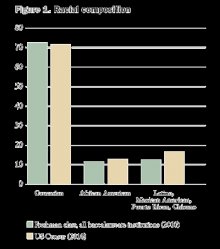For years, American higher education institutions have been working hard to increase the racial and ethnic diversity of our campuses. This work is driven in part by arguments for social justice and the felt need for equal and expanded access to higher education. Our society is diverse, and our campuses should reflect that. We also seek diverse student bodies, because we know from numerous research studies that engaging with others from a variety of different backgrounds improves the learning environment. Our learning is impoverished when we are in a homogeneous group of like-minded individuals who share the same kinds of experiences, beliefs, and aspirations. As the Association of American Colleges and Universities (AAC&U) so often points out, diversity should be talked about as “inclusive excellence, ” for only when a campus is truly inclusive can it make a claim to excellence.
And we have made significant progress in improving the racial and ethnic diversity in our institutions. Over the past forty years, our freshman classes have changed from over 90 percent white to about 73 percent white. According to the most recent Chronicle of Higher Education survey (2011), African Americans now comprise 11.5 percent of our freshman classes, and 12.4 percent of first-year students are Latino, Mexican American, Puerto Rican, or Chicano. As figure 1 shows (see page 8), this is remarkably close to national census data from 2010, which report that 72.4 percent of Americans are white and 12.6 percent are black. There is, however, still a considerable disparity between the prevalence of Hispanics and Latinos on our campuses and in the population as a whole: 16.3 percent of the national population identify as Hispanic, Latino, or Mexican in terms of national origin.1

While our progress to date in diversifying our student populations is laudable, we can and should do more to improve inclusiveness on our campuses as a whole. Nationally in 2009, only 7 percent of faculty were black and 4 percent were Hispanic, while only 19 percent of all executive, managerial, and administrative staff were nonwhite (Snyder and Dillow 2011). Race continues to be a source of division, misunderstanding, prejudice, and discrimination on our campuses and in our country. Educational institutions have an obligation to address these inequalities in their admissions policies, their student life programming, their hiring, and their curricula. But there are other dimensions of diversity that have long been underemphasized and that also deserve serious attention.







